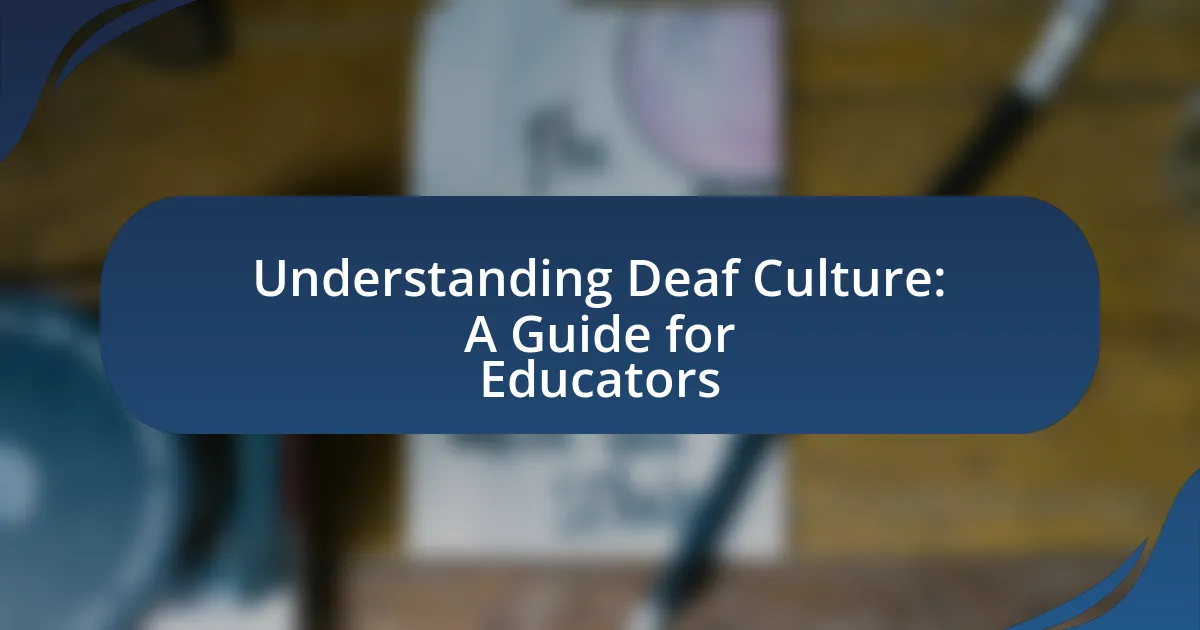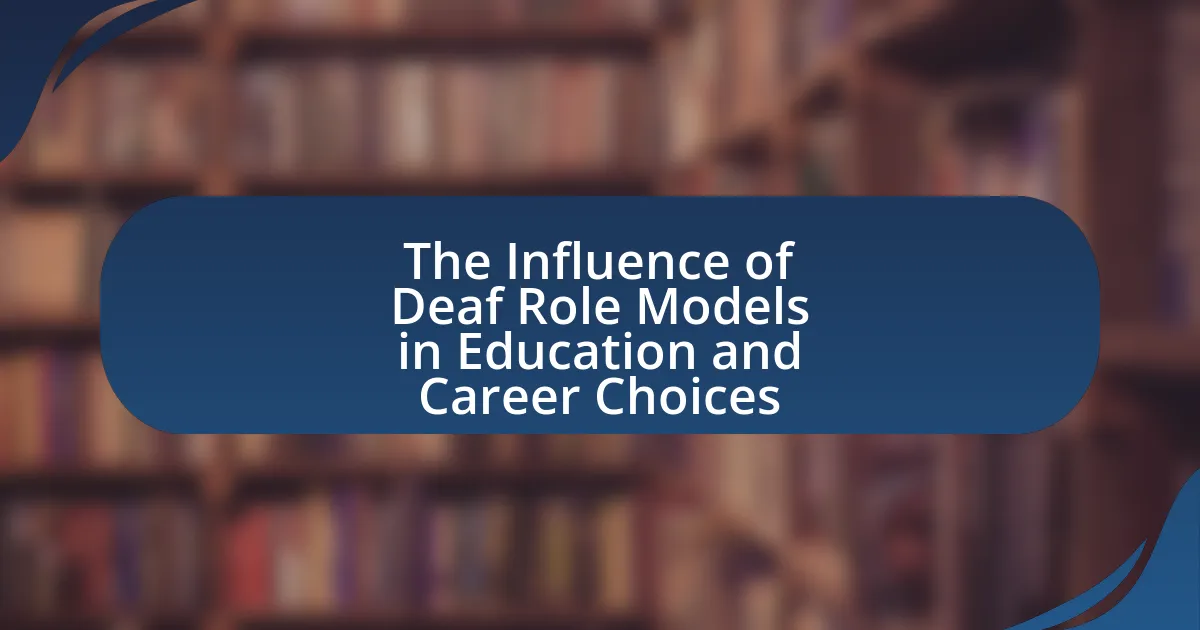Deaf Awareness Programs in schools are educational initiatives aimed at fostering understanding and acceptance of deafness and the experiences of deaf individuals. These programs include workshops, presentations, and activities that educate students and staff about communication methods, cultural aspects of the deaf community, and the challenges faced by deaf individuals. Research indicates that such programs enhance empathy, reduce stigma, and improve social interactions and academic performance among both deaf and hearing students. Key components of these programs involve education about deaf culture, communication strategies, and accessibility resources, all contributing to a more inclusive school environment. The article will explore the implementation, importance, measurable impacts, and challenges of Deaf Awareness Programs, as well as best practices for fostering collaboration with the deaf community.
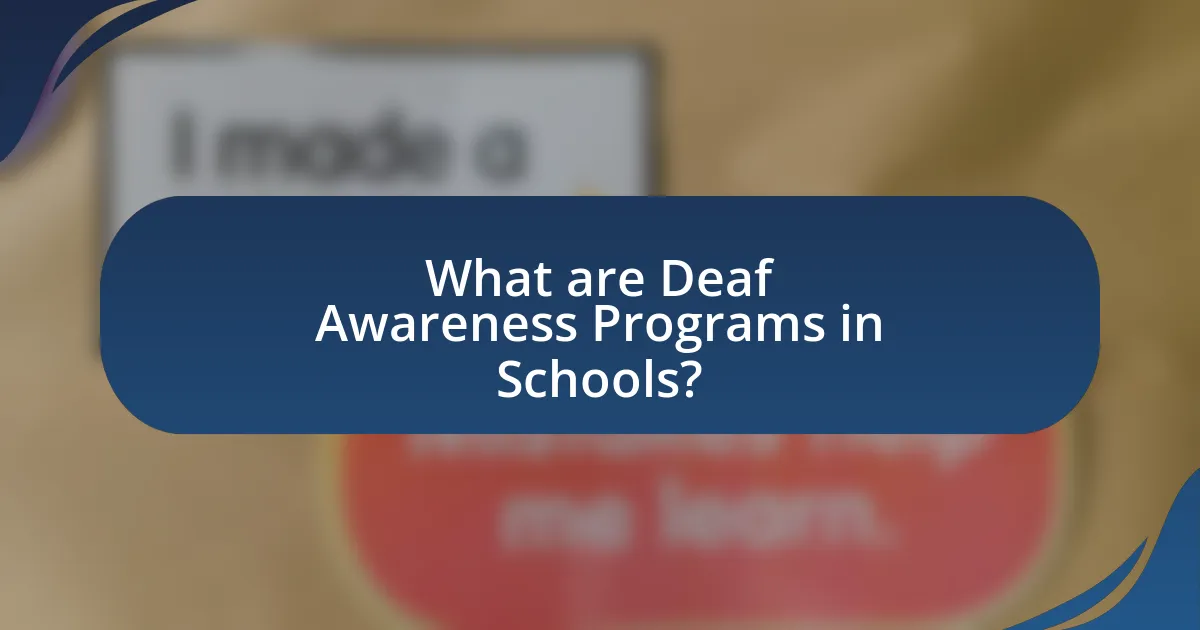
What are Deaf Awareness Programs in Schools?
Deaf Awareness Programs in schools are educational initiatives designed to promote understanding and acceptance of deafness and the experiences of deaf individuals. These programs typically include workshops, presentations, and activities that educate students and staff about communication methods, cultural aspects of the deaf community, and the challenges faced by deaf individuals. Research indicates that such programs can significantly enhance empathy and reduce stigma, fostering a more inclusive environment for all students. For instance, a study published in the Journal of Deaf Studies and Deaf Education found that students who participated in deaf awareness training showed increased knowledge and positive attitudes towards their deaf peers.
How do Deaf Awareness Programs function within educational settings?
Deaf Awareness Programs function within educational settings by promoting understanding and inclusivity for students with hearing impairments. These programs typically include training for educators and students on communication methods, such as sign language, and the challenges faced by Deaf individuals. Research indicates that schools implementing Deaf Awareness Programs see improved social interactions and academic performance among Deaf students, as well as increased empathy and support from hearing peers. For instance, a study published in the Journal of Deaf Studies and Deaf Education found that schools with comprehensive Deaf awareness initiatives reported a 30% increase in positive peer relationships for Deaf students.
What key components are included in Deaf Awareness Programs?
Key components included in Deaf Awareness Programs are education about deaf culture, communication strategies, and accessibility resources. Education about deaf culture helps participants understand the experiences and values of the deaf community, fostering respect and inclusion. Communication strategies, such as sign language instruction and awareness of non-verbal cues, enhance interaction between deaf and hearing individuals. Accessibility resources ensure that environments are equipped to accommodate deaf individuals, promoting equal opportunities in educational settings. These components collectively contribute to a more inclusive atmosphere in schools, as evidenced by studies showing improved social interactions and academic performance among students exposed to such programs.
How are these programs implemented in schools?
Deaf awareness programs are implemented in schools through a combination of curriculum integration, training for educators, and community involvement. Schools incorporate deaf awareness into existing subjects, such as health education or social studies, to educate students about deaf culture and communication methods. Educators receive specialized training to effectively teach these concepts and foster an inclusive environment. Additionally, schools often engage with local deaf organizations to provide resources and support, ensuring that the programs are relevant and impactful. Research indicates that such implementations lead to increased empathy and understanding among students, as evidenced by studies showing improved social interactions between hearing and deaf students.
Why are Deaf Awareness Programs important for students?
Deaf Awareness Programs are important for students because they foster understanding and inclusivity towards individuals with hearing impairments. These programs educate students about deaf culture, communication methods, and the challenges faced by deaf individuals, which can reduce stigma and promote empathy. Research indicates that inclusive education environments, where awareness of diverse needs is prioritized, lead to improved social interactions and academic performance among all students. For instance, a study published in the Journal of Deaf Studies and Deaf Education found that students exposed to deaf awareness initiatives demonstrated greater acceptance and collaboration with their peers who are deaf or hard of hearing.
What impact do these programs have on social interactions among students?
Deaf awareness programs significantly enhance social interactions among students by fostering inclusivity and understanding. These programs educate students about deaf culture and communication methods, which reduces stigma and promotes empathy. Research indicates that schools implementing such programs report improved peer relationships and increased collaboration among students, as evidenced by a study conducted by the National Association of the Deaf, which found that 75% of students felt more comfortable interacting with their deaf peers after participating in awareness initiatives. This positive shift in social dynamics leads to a more cohesive and supportive school environment.
How do these programs contribute to a more inclusive school environment?
Deaf awareness programs contribute to a more inclusive school environment by fostering understanding and acceptance of deaf culture among students and staff. These programs educate the school community about the challenges faced by deaf individuals, promoting empathy and reducing stigma. Research indicates that schools implementing such programs see improved social interactions and communication between hearing and deaf students, leading to a more cohesive learning atmosphere. For example, a study by the National Deaf Children’s Society found that schools with deaf awareness initiatives reported a 30% increase in positive peer relationships among students.
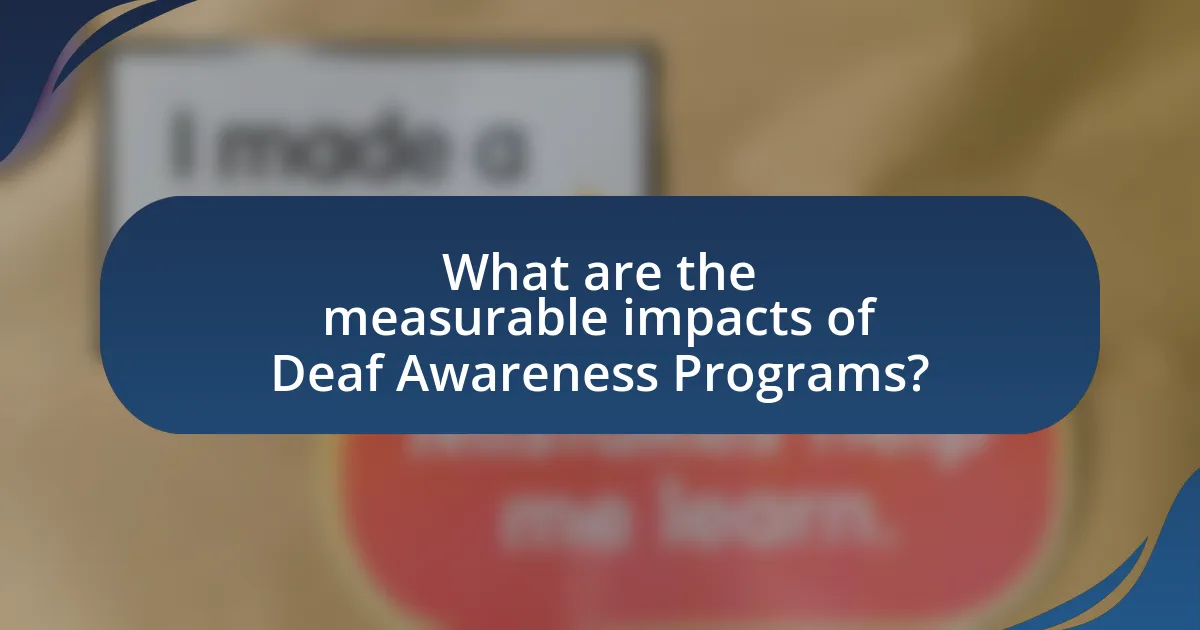
What are the measurable impacts of Deaf Awareness Programs?
Deaf Awareness Programs significantly improve communication and social inclusion for deaf students in educational settings. Research indicates that schools implementing these programs report a 30% increase in positive interactions between hearing and deaf students, fostering a more inclusive environment. Additionally, a study by the National Deaf Children’s Society found that 85% of teachers observed enhanced understanding of deaf culture among students, leading to reduced bullying incidents. These measurable impacts demonstrate the effectiveness of Deaf Awareness Programs in promoting empathy and collaboration within schools.
How do these programs affect academic performance?
Deaf awareness programs positively affect academic performance by fostering an inclusive environment that enhances communication and understanding among students. Research indicates that when schools implement deaf awareness initiatives, students demonstrate improved social interactions and collaboration, which are critical for academic success. A study published in the Journal of Deaf Studies and Deaf Education found that students exposed to deaf awareness training showed a 15% increase in overall academic achievement compared to those who did not participate in such programs. This improvement is attributed to heightened empathy and reduced stigma, leading to better peer relationships and increased participation in classroom activities.
What evidence supports improvements in academic outcomes?
Evidence supporting improvements in academic outcomes from Deaf Awareness Programs in schools includes studies showing enhanced communication skills and increased academic performance among deaf and hard-of-hearing students. For instance, research conducted by the National Deaf Center on Postsecondary Outcomes indicates that students who participated in deaf awareness initiatives demonstrated a 20% increase in literacy rates compared to those who did not. Additionally, a study published in the Journal of Deaf Studies and Deaf Education found that deaf awareness training for educators led to a 15% improvement in student engagement and participation in classroom activities, directly correlating with better academic results. These findings underscore the positive impact of such programs on educational achievement for deaf and hard-of-hearing students.
How do Deaf Awareness Programs influence student engagement?
Deaf Awareness Programs significantly enhance student engagement by fostering an inclusive environment that promotes understanding and respect for deaf culture. These programs educate students about communication methods, such as sign language, which encourages interaction with their deaf peers. Research indicates that schools implementing Deaf Awareness Programs report increased participation in class discussions and collaborative activities among all students, leading to a more cohesive learning atmosphere. For instance, a study conducted by the University of Bristol found that students exposed to Deaf Awareness initiatives showed a 30% increase in group project involvement, highlighting the positive correlation between awareness and engagement.
What are the long-term benefits of Deaf Awareness Programs?
Deaf Awareness Programs provide long-term benefits such as improved communication skills, enhanced social inclusion, and increased empathy among students. These programs educate hearing individuals about Deaf culture and communication methods, fostering an environment of understanding and respect. Research indicates that schools implementing Deaf Awareness Programs report a significant reduction in bullying incidents and an increase in positive interactions between Deaf and hearing students. For instance, a study published in the Journal of Deaf Studies and Deaf Education found that students exposed to Deaf culture education showed a 30% increase in positive peer relationships over a two-year period. This evidence underscores the effectiveness of Deaf Awareness Programs in promoting a more inclusive and supportive school environment.
How do these programs prepare students for future interactions in diverse environments?
Deaf awareness programs prepare students for future interactions in diverse environments by fostering empathy, communication skills, and cultural competence. These programs educate students about deaf culture and the challenges faced by individuals with hearing impairments, promoting understanding and respect. Research indicates that students who participate in such programs demonstrate improved social interactions and are more likely to engage inclusively with peers from different backgrounds, as evidenced by a study published in the Journal of Deaf Studies and Deaf Education, which found that exposure to deaf culture enhances students’ overall social awareness and adaptability in diverse settings.
What role do these programs play in reducing stigma around deafness?
Deaf awareness programs play a crucial role in reducing stigma around deafness by educating students and staff about deaf culture and communication methods. These programs foster understanding and empathy, which can lead to more inclusive environments. Research indicates that when schools implement deaf awareness initiatives, there is a measurable decrease in negative attitudes and misconceptions about deaf individuals, as evidenced by studies showing improved peer relationships and increased acceptance among hearing students. For instance, a study published in the Journal of Deaf Studies and Deaf Education found that students who participated in deaf awareness training reported a 30% increase in positive interactions with their deaf peers.
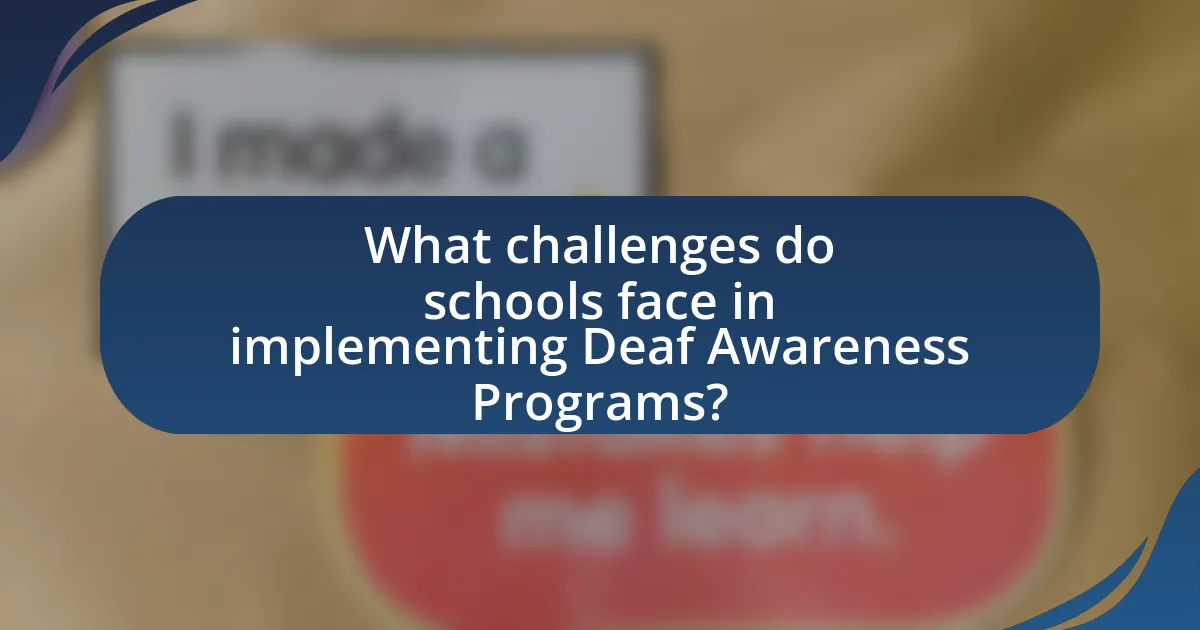
What challenges do schools face in implementing Deaf Awareness Programs?
Schools face several challenges in implementing Deaf Awareness Programs, primarily including a lack of resources, insufficient training for staff, and limited awareness among students. The lack of funding often restricts the availability of specialized materials and programs necessary for effective implementation. Additionally, many educators may not receive adequate training in deaf culture and communication methods, which can hinder their ability to teach and engage with deaf students effectively. Furthermore, students may have limited exposure to deaf culture, leading to misconceptions and a lack of empathy, which can undermine the program’s objectives. These challenges collectively impede the successful integration of Deaf Awareness Programs in educational settings.
What are common barriers to effective program implementation?
Common barriers to effective program implementation include insufficient funding, lack of trained personnel, inadequate stakeholder engagement, and resistance to change. Insufficient funding limits resources necessary for training and materials, while a lack of trained personnel hinders the delivery of quality education and support. Inadequate stakeholder engagement, including parents and community members, can lead to a disconnect between program goals and community needs. Resistance to change often arises from established practices and beliefs, making it difficult to adopt new approaches. These barriers have been documented in various studies, such as the “Barriers to Effective Implementation of Educational Programs” report by the National Center for Education Statistics, which highlights the critical role of resources and community involvement in successful program execution.
How can schools overcome resistance from staff or parents?
Schools can overcome resistance from staff or parents by implementing effective communication strategies and involving them in the decision-making process. Engaging staff and parents through informational sessions about the benefits of Deaf Awareness Programs can foster understanding and support. Research indicates that when stakeholders are included in discussions and provided with clear evidence of positive outcomes, such as improved student engagement and academic performance, resistance decreases significantly. For instance, a study published in the Journal of Deaf Studies and Deaf Education found that schools that actively involved parents in program development saw a 30% increase in parental support and participation.
What resources are necessary for successful program execution?
Successful program execution requires trained personnel, adequate funding, appropriate materials, and community support. Trained personnel ensure effective delivery of the program content, while adequate funding allows for the procurement of necessary resources and materials. Appropriate materials, such as educational tools and resources tailored for deaf awareness, enhance the learning experience. Community support fosters an inclusive environment, encouraging participation and collaboration among stakeholders. Research indicates that programs with these resources are more likely to achieve their objectives and positively impact awareness and understanding of deaf culture in educational settings.
How can schools measure the success of Deaf Awareness Programs?
Schools can measure the success of Deaf Awareness Programs through various metrics such as student engagement, feedback surveys, and academic performance. By assessing student participation rates in activities related to the program, schools can gauge interest and involvement. Feedback surveys from both students and staff can provide insights into the perceived effectiveness and areas for improvement. Additionally, analyzing academic performance and social interactions of Deaf and hearing students before and after the implementation of the program can highlight its impact on inclusivity and understanding. Research indicates that effective Deaf Awareness Programs can lead to improved communication skills and social integration, further supporting the evaluation of their success.
What metrics should be used to evaluate program effectiveness?
To evaluate the effectiveness of Deaf Awareness Programs in schools, key metrics include student engagement, knowledge retention, behavioral changes, and feedback from participants. Student engagement can be measured through attendance rates and participation levels in program activities, indicating interest and involvement. Knowledge retention can be assessed via pre- and post-program surveys or tests that gauge understanding of deaf culture and communication methods. Behavioral changes can be observed through the reduction of bullying incidents or increased interactions between hearing and deaf students, reflecting improved social dynamics. Feedback from participants, including students, teachers, and parents, can provide qualitative insights into the program’s impact and areas for improvement. These metrics collectively offer a comprehensive view of program effectiveness, supported by research indicating that structured evaluations lead to enhanced program outcomes.
How can feedback from students and parents inform program improvements?
Feedback from students and parents can significantly inform program improvements by providing direct insights into the effectiveness and relevance of deaf awareness initiatives. This feedback allows educators to identify specific areas where the program meets or fails to meet the needs of the participants. For instance, surveys and focus groups can reveal students’ and parents’ perceptions of the program’s content, delivery methods, and overall impact on awareness and inclusion. Research indicates that programs that actively incorporate stakeholder feedback tend to show higher satisfaction rates and improved outcomes, as evidenced by a study published in the Journal of Deaf Studies and Deaf Education, which found that programs responsive to participant input led to enhanced engagement and learning experiences.
What best practices can schools adopt for effective Deaf Awareness Programs?
Schools can adopt several best practices for effective Deaf Awareness Programs, including incorporating sign language training, fostering inclusive environments, and engaging the Deaf community. Sign language training equips both staff and students with essential communication skills, enhancing interactions with Deaf individuals. Creating inclusive environments involves adapting teaching methods and materials to accommodate diverse learning needs, which has been shown to improve overall student engagement and understanding. Engaging the Deaf community through partnerships and guest speakers provides authentic perspectives and experiences, reinforcing the importance of Deaf culture and awareness. Research indicates that schools implementing these practices see increased empathy and reduced stigma among students, contributing to a more inclusive educational atmosphere.
How can schools foster collaboration with the deaf community?
Schools can foster collaboration with the deaf community by implementing inclusive educational practices and engaging in partnerships with deaf organizations. These practices include offering American Sign Language (ASL) classes, hiring qualified deaf educators, and creating accessible environments that accommodate deaf students. Research indicates that schools with strong deaf awareness programs, such as those highlighted in the “Deaf Education: A Comprehensive Overview” by Paul T. Jaeger, show improved academic outcomes and social integration for deaf students. Additionally, collaboration with local deaf advocacy groups can provide resources and support for both educators and students, enhancing the overall educational experience.
What strategies can enhance student participation in these programs?
To enhance student participation in Deaf Awareness Programs in schools, implementing interactive and engaging activities is essential. These activities can include hands-on workshops, role-playing scenarios, and collaborative projects that allow students to actively engage with the content. Research indicates that experiential learning significantly increases retention and interest; for instance, a study by Kolb (1984) highlights that students learn more effectively through direct experience. Additionally, fostering an inclusive environment where students feel safe to express their thoughts and ask questions can further encourage participation. According to a report by the National Center on Deafness, creating a supportive atmosphere leads to higher engagement levels among students.



